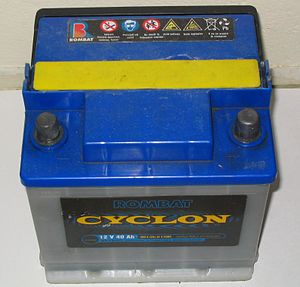Lead acid battery

Lead–acid car battery
|
|
| Specific energy | 33–42 Wh/kg |
|---|---|
| Energy density | 60–110 Wh/L |
| Specific power | 180 W/kg |
| Charge/discharge efficiency | 50–95% |
| Energy/consumer-price | 7 (sld) to 18 (fld) Wh/US$ |
| Self-discharge rate | 3–20%/month |
| Cycle durability | 500–800 cycles |
| Nominal cell voltage | 2.1 V |
| Charge temperature interval | Min. −35 °C, max. 45 °C |
The lead-acid battery was invented in 1859 by French physicist Gaston Planté and is the oldest type of rechargeable battery. Despite having a very low energy-to-weight ratio and a low energy-to-volume ratio, its ability to supply high surge currents means that the cells have a relatively large power-to-weight ratio. These features, along with their low cost, makes it attractive for use in motor vehicles to provide the high current required by automobile starter motors.
As they are inexpensive compared to newer technologies, lead-acid batteries are widely used even when surge current is not important and other designs could provide higher energy densities. Large-format lead-acid designs are widely used for storage in backup power supplies in cell phone towers, high-availability settings like hospitals, and stand-alone power systems. For these roles, modified versions of the standard cell may be used to improve storage times and reduce maintenance requirements. Gel-cells and absorbed glass-mat batteries are common in these roles, collectively known as VRLA (valve-regulated lead-acid) batteries.
Lead–acid battery sales account for 40–45% of the value from batteries sold worldwide (1999, not including China and Russia), a manufacturing market value of about $15 billion.
The French scientist Gautherot observed in 1801 that wires that had been used for electrolysis experiments would themselves provide a small amount of "secondary" current after the main battery had been disconnected. In 1859, Gaston Planté's lead–acid battery was the first battery that could be recharged by passing a reverse current through it. Planté's first model consisted of two lead sheets separated by rubber strips and rolled into a spiral. His batteries were first used to power the lights in train carriages while stopped at a station. In 1881, Camille Alphonse Faure invented an improved version that consisted of a lead grid lattice, into which a lead oxide paste was pressed, forming a plate. This design was easier to mass-produce. An early manufacturer (from 1886) of lead–acid batteries was Henri Tudor.
...
Wikipedia
